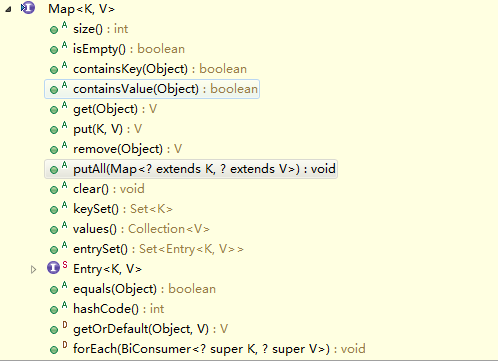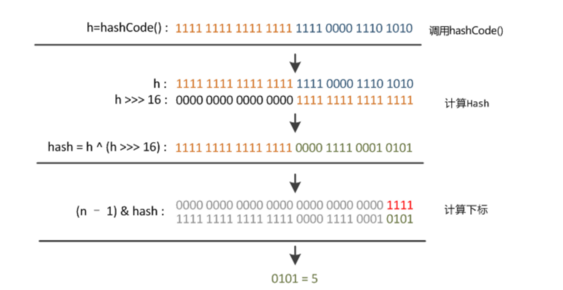Java 集合学习--HashMap
一、HashMap 定义
HashMap 是一个基于散列表(哈希表)实现的键值对集合,每个元素都是key-value对,jdk1.8后,底层数据结构涉及到了数组、链表以及红黑树。目的进一步的优化HashMap的性能和效率。允许key和value为NULL,同样非线程安全。

①、继承AbstractMap抽象类,AbstractMap实现Map接口,实现部分方法的。同样在上面HashMap的结构中,HashMap同样实现了Map接口,这样做是否有什么深层次的用意呢?网上查阅资料发现,这种写法只是一种失误,在java集合框架中发现很多这种写法,不用过于在乎这种失误。
②、实现Map接口,Map类的顶层接口,Map接口定义了一组键值对映射通用的操作。储存一组成对的键-值对象,提供key(键)到value(值)的映射,Map中的key不要求有序,不允许重复。value同样不要求有序,但可以重复。

③、实现 Cloneable 接口和Serializable接口,分别支持对象的克隆与对象的序列化
二、字段属性
//1.序列化版本标记,序列化与反序列化时发挥作用 private static final long serialVersionUID = 362498820763181265L; //2.HashMap集合默认初始化容量,1*2的4次方,即16 static final int DEFAULT_INITIAL_CAPACITY = 1 << 4 //3.集合最大容量 static final int MAXIMUM_CAPACITY = 1 << 30; //4.默认的加载因子 static final float DEFAULT_LOAD_FACTOR = 0.75f; //5.当桶(bucket)上的结点数大于这个值时会转成红黑树(JDK1.8新增) static final int TREEIFY_THRESHOLD = 8; //6.当bucket上的节点数少于这个值得时候,数转化成链表 static final int UNTREEIFY_THRESHOLD = 6; //7.当集合的容量大于这个值的时候,HashMap中桶的节点进行树形化 static final int MIN_TREEIFY_CAPACITY = 64; //8.Node数组,Node是HashMap中自定义hash节点类。 transient Node<K,V>[] table; //9.保存缓存的entrySet transient Set<Map.Entry<K,V>> entrySet; //10.集合元素个数,即HashMap中键值对的个数 transient int size; //11.集合修改次数 transient int modCount //12.下次扩容的临界值,通常称为阀值,等于capacity * load factor int threshold; //13.散列表的加载因子,可自己指定 final float loadFactor;
三、构造方法
①、默认无参构造器,设置加载因子为默认加载因子0.75

②、带参构造器
1)指定初始化容量,使用默认加载因子

2)指定初始化容量,使用自定加载因子

四、常用方法
1.添加元素(键值对)

//添加键值对 public V put(K key, V value) { return putVal(hash(key), key, value, false, true); } ------------------------------------------------------------------------- //具体的步骤 //1.通过key计算hash值 static final int hash(Object key) { int h; return (key == null) ? 0 : (h = key.hashCode()) ^ (h >>> 16); } //2.如果table数组为null,初始化数组,通过hash值确定键值对在数组中的索引位置 //3.确定元素在数组中的位置后,判断那个位置的元素的key是否与添加的key一样,如果一致则直接覆盖老的键值对,如果不一样则判断结点的类型,是否是树,如果是树则在树中插入一个新构造的树结点 //4.如果数组对应位置上的节点不是树,则是链表,这个时候要么在链表的最后插入新的Node节点,要么是当发现链表的节点个数大于8,并且集合元素个数大于64的时候,则将链表转换成红黑树,要么则是进行扩容。 ------------------------------------------------------------------------- //具体细节如下: /** * Implements Map.put and related methods * * @param hash hash for key 哈希值 * @param key the key 键 * @param value the value to pu t值 * @param onlyIfAbsent if true, don't change existing value * @param evict if false, the table is in creation mode. false表示table处于创建模式 * @return previous value, or null if none */ final V putVal(int hash, K key, V value, boolean onlyIfAbsent, boolean evict) { Node<K,V>[] tab; Node<K,V> p; int n, i; if ((tab = table) == null || (n = tab.length) == 0) n = (tab = resize()).length;//首次进行数组的初始化,resize主要用来进行扩容的 if ((p = tab[i = (n - 1) & hash]) == null)//等同于取模,确定数组中索引位置 tab[i] = newNode(hash, key, value, null); else { Node<K,V> e; K k; if (p.hash == hash && ((k = p.key) == key || (key != null && key.equals(k)))) e = p; else if (p instanceof TreeNode) e = ((TreeNode<K,V>)p).putTreeVal(this, tab, hash, key, value); else { for (int binCount = 0; ; ++binCount) { if ((e = p.next) == null) { p.next = newNode(hash, key, value, null); if (binCount >= TREEIFY_THRESHOLD - 1) // -1 for 1st treeifyBin(tab, hash); break; } if (e.hash == hash && ((k = e.key) == key || (key != null && key.equals(k)))) break; p = e; } } if (e != null) { // existing mapping for key V oldValue = e.value; if (!onlyIfAbsent || oldValue == null) e.value = value; afterNodeAccess(e); return oldValue; } } ++modCount; if (++size > threshold) resize(); afterNodeInsertion(evict); return null; }
2.查找元素(键值对)
①、通过 key 查找 value,首先通过key计算hash值,再根绝hash值确定key在所在数组的索引位置后,最后遍历其后面的链表或者红黑树找到对应的value.
public V get(Object key) { Node<K,V> e; //确定key的hash值,计算方法与插入的时候一致 return (e = getNode(hash(key), key)) == null ? null : e.value; } final Node<K,V> getNode(int hash, Object key) { Node<K,V>[] tab; Node<K,V> first, e; int n; K k; if ((tab = table) != null && (n = tab.length) > 0 && (first = tab[(n - 1) & hash]) != null) {//数组不为空,并且在相关的位置存在Node结点。 if (first.hash == hash && // always check first node ((k = first.key) == key || (key != null && key.equals(k))))//如果在第一个位置存在则直接返回Nnode结点 return first; //判断结点类型,确定是链表还是红黑树,遍历链表或者红黑树,找到对应的节点。 if ((e = first.next) != null) { if (first instanceof TreeNode) return ((TreeNode<K,V>)first).getTreeNode(hash, key); do { if (e.hash == hash && ((k = e.key) == key || (key != null && key.equals(k)))) return e; } while ((e = e.next) != null); } } return null; }
②、判断是否存在给定的 key或者 value,
//判断集合中是否存在某个键,原理与查找键值类似 public boolean containsKey(Object key) { return getNode(hash(key), key) != null; } //遍历整个数组,明显效率很低 public boolean containsValue(Object value) { Node<K,V>[] tab; V v; if ((tab = table) != null && size > 0) { //遍历桶 for (int i = 0; i < tab.length; ++i) { //遍历桶中的每个节点元素 for (Node<K,V> e = tab[i]; e != null; e = e.next) { if ((v = e.value) == value || (value != null && value.equals(v))) return true; } } } return false; }
3.删除元素(键值对),删除的原理本质上是类似通过key查找value,首先通过key计算hash值,通过hash值确定key在散列表中的位置,由于key不重复,所以确定位置后,要么是遍历链表,要么遍历红黑树找到对应key所在的节点,找到node节点后删除。

public V remove(Object key) { Node<K,V> e; return (e = removeNode(hash(key), key, null, false, true)) == null ? null : e.value; } final Node<K,V> removeNode(int hash, Object key, Object value, boolean matchValue, boolean movable) { Node<K,V>[] tab; Node<K,V> p; int n, index; //(n - 1) & hash找到桶的位置 if ((tab = table) != null && (n = tab.length) > 0 && (p = tab[index = (n - 1) & hash]) != null) { Node<K,V> node = null, e; K k; V v; //如果键的值与链表第一个节点相等,则将 node 指向该节点 if (p.hash == hash && ((k = p.key) == key || (key != null && key.equals(k)))) node = p; //如果桶节点存在下一个节点 else if ((e = p.next) != null) { //节点为红黑树 if (p instanceof TreeNode) node = ((TreeNode<K,V>)p).getTreeNode(hash, key);//找到需要删除的红黑树节点 else { do {//遍历链表,找到待删除的节点 if (e.hash == hash && ((k = e.key) == key || (key != null && key.equals(k)))) { node = e; break; } p = e; } while ((e = e.next) != null); } } //删除节点,并进行调节红黑树平衡 if (node != null && (!matchValue || (v = node.value) == value || (value != null && value.equals(v)))) { if (node instanceof TreeNode) ((TreeNode<K,V>)node).removeTreeNode(this, tab, movable); else if (node == p) tab[index] = node.next; else p.next = node.next; ++modCount; --size; afterNodeRemoval(node); return node; } } return null; }
4.遍历集合,map的遍历方法有多种,通常推荐的迭代器遍历,不过遍历的本质都是循环整个table数组,对数组的每个桶进行遍历。
1 public class HashMapDemo { 2 3 public static void main(String[] args) { 4 5 HashMap<String, String> map = new HashMap<>(); 6 map.put("1", "a"); 7 map.put("2", "b"); 8 map.put("3", "c"); 9 //通过获取所有的key后,再通过key获取value的方式遍历 10 for(String str : map.keySet()){ 11 System.out.print(map.get(str)+" "); 12 } 13 System.out.println("\n----------------"); 14 for(Entry entry : map.entrySet()){ 15 System.out.println(entry.getKey()+" "+entry.getValue()); 16 } 17 } 18 19 }
输出结果:
a b c ---------------- 1 a 2 b 3 c
四、HashMap的hash值得秘密
1.HashMap 是数组+链表+红黑树的组合,hash值主要牵扯到它在hash表,也叫散列表中的位置。Hash表是一种根据关键字值(key - value)而直接进行访问的数据结构。也就是说它通过把关键码值映射到表中的一个位置来访问记录,它的查找速度非常快,查找一个元素可用通过key的hash值直接确定所在的位置。HashMap中确定key的值有其特定的算法,并且最终确定在散列表中的位置还需要经过&运算。具体如下:
static final int hash(Object key) { int h; return (key == null) ? 0 : (h = key.hashCode()) ^ (h >>> 16); } i = (table.length - 1) & hash;//这一步是在后面添加元素putVal()方法中进行位置的确定
主要分为三步:
①、取 hashCode 值: key.hashCode(),注意hashcode()的值是key对象在堆中的地址经过特殊的hahs算法映射后的一个int值
②、高位参与运算:h>>>16
③、取模运算:(n-1) & hash,注意:在n是偶数的时候,(n-1)&hash==hash%n;这也是为什么HashMap的容量为2的n次方的原因,便于使用按位与运算代替取模,因为位运算的速度远快于取模。这是一种优化。
2.为什么要进行(h = k.hashCode()) ^ (h >>> 16)?
通过hashCode()的高16位 异或 低16位实现的:(h = k.hashCode()) ^ (h >>> 16),主要是从速度、功效、质量来考虑的,这么做可以在数组table的length比较小的时候,也能保证考虑到高低Bit都参与到Hash的计算中,同时不会有太大的开销。具体如下:

五、HashMap的扩容机制
当HashMap 集合的元素已经大于了最大承载容量threshold(capacity * loadFactor)的时候,会进行扩容,即扩大数组的长度。通常不指定集合容量的时候,初始容量为16.阀值为12.当集合的元素个数大于12的时候,集合进行扩容,扩大打原来集合的2倍大小,如下初始集合的首次扩容为32,依次是64,128。对应的阀值进行变化。依次为24,48,96。在扩容的同时,需要重新进行键值对的hash映射。在jdk1.8之前,扩容首先是创建一个新的大容量数组,然后依次重新计算原集合所有元素的索引,然后重新赋值。如果数组某个位置发生了hash冲突,使用的是单链表的头插入方法,同一位置的新元素总是放在链表的头部,这样与原集合链表对比,扩容之后的可能就是倒序的链表了。在jdk1.8后,进行进一步的优化,使扩容的时候具体细节如下:

final Node<K,V>[] resize() { Node<K,V>[] oldTab = table; int oldCap = (oldTab == null) ? 0 : oldTab.length; int oldThr = threshold; int newCap, newThr = 0; if (oldCap > 0) { if (oldCap >= MAXIMUM_CAPACITY) { threshold = Integer.MAX_VALUE; return oldTab; } else if ((newCap = oldCap << 1) < MAXIMUM_CAPACITY && oldCap >= DEFAULT_INITIAL_CAPACITY) newThr = oldThr << 1; // double threshold } else if (oldThr > 0) // initial capacity was placed in threshold newCap = oldThr; else { // zero initial threshold signifies using defaults newCap = DEFAULT_INITIAL_CAPACITY; newThr = (int)(DEFAULT_LOAD_FACTOR * DEFAULT_INITIAL_CAPACITY); } if (newThr == 0) { float ft = (float)newCap * loadFactor; newThr = (newCap < MAXIMUM_CAPACITY && ft < (float)MAXIMUM_CAPACITY ? (int)ft : Integer.MAX_VALUE); } threshold = newThr; @SuppressWarnings({"rawtypes","unchecked"}) Node<K,V>[] newTab = (Node<K,V>[])new Node[newCap]; table = newTab; if (oldTab != null) { for (int j = 0; j < oldCap; ++j) { Node<K,V> e; if ((e = oldTab[j]) != null) { oldTab[j] = null; if (e.next == null) newTab[e.hash & (newCap - 1)] = e; else if (e instanceof TreeNode) ((TreeNode<K,V>)e).split(this, newTab, j, oldCap); else { // preserve order Node<K,V> loHead = null, loTail = null; Node<K,V> hiHead = null, hiTail = null; Node<K,V> next; do { next = e.next; if ((e.hash & oldCap) == 0) { if (loTail == null) loHead = e; else loTail.next = e; loTail = e; } else { if (hiTail == null) hiHead = e; else hiTail.next = e; hiTail = e; } } while ((e = next) != null); if (loTail != null) { loTail.next = null; newTab[j] = loHead; } if (hiTail != null) { hiTail.next = null; newTab[j + oldCap] = hiHead; } } } } } return newTab; }
从上面的源码可以看出,容量的增长是成倍增长,容量的大小为2的n次幂,那么扩容的时候,元素的key的hash值要么在原来位置不变,要么在原来的位置再移动2次幂的位置。不需要再次进行按位与运算,进一步优化扩容的机制。仅仅需要看看原来的hash值新增的那个bit是1还是0就好了,是0的话索引没变,是1的话索引变成“原索引+oldCap”。
六、总结
- HashMap中两个重要的属性,初始容量和加载因子,这两个属性影响HashMap的性能,它的设值需要非常谨慎。初始容量是创建哈希表时的容量,加载因子是哈希表在其容量自动增加之前可以达到多满的一种尺度,两者决定何时进行扩容。
- HashMap中key和value都允许为null。
- 哈希表的容量一定要是2的整数次幂,length为2的整数次幂的话,h&(length-1)就相当于对h%length,这样便保证了散列的均匀,使不同hash值发生碰撞的概率,同时也提升了效率。




